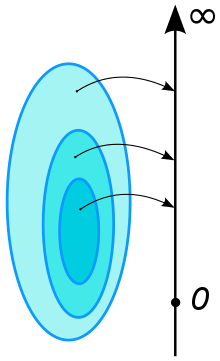Measure (mathematics)
In mathematics, the concept of a measure is a generalization and formalization of geometrical measures (length, area, volume) and other common notions, such as magnitude, mass, and probability of events.These seemingly distinct concepts have many similarities and can often be treated together in a single mathematical context.The intuition behind this concept dates back to ancient Greece, when Archimedes tried to calculate the area of a circle.[1][2] But it was not until the late 19th and early 20th centuries that measure theory became a branch of mathematics.The foundations of modern measure theory were laid in the works of Émile Borel, Henri Lebesgue, Nikolai Luzin, Johann Radon, Constantin Carathéodory, and Maurice Fréchet, among others.to the extended real number line is called a measure if the following conditions hold: If at least one setis met automatically due to countable additivity:Radon measures have an alternative definition in terms of linear functionals on the locally convex topological vector space of continuous functions with compact support.In physics an example of a measure is spatial distribution of mass (see for example, gravity potential), or another non-negative extensive property, conserved (see conservation law for a list of these) or not.Negative values lead to signed measures, see "generalizations" below.One example is the Flow Induced Probability Measure in GFlowNet.which all have infinite Lebesgue measure, but the intersection is empty.A measure can be extended to a complete one by considering the σ-algebra of subsetsso both of them have at most countably many discontinuities and thus they are continuous almost everywhere, relative to the Lebesgue measure.The second condition is equivalent to the statement that the ideal of null sets isFor example, the real numbers with the standard Lebesgue measure are σ-finite but not finite.there are countably many such intervals, each has measure 1, and their union is the entire real line.Alternatively, consider the real numbers with the counting measure, which assigns to each finite set of reals the number of points in the set.This measure space is not σ-finite, because every set with finite measure contains only finitely many points, and it would take uncountably many such sets to cover the entire real line.The σ-finite measure spaces have some very convenient properties; σ-finiteness can be compared in this respect to the Lindelöf property of topological spaces.We give some nice, explicit formulas, which some authors may take as definition, for the semifinite part: SinceMeasures that are not semifinite are very wild when restricted to certain sets.S-finite measures are more general than sigma-finite ones and have applications in the theory of stochastic processes.If the axiom of choice is assumed to be true, it can be proved that not all subsets of Euclidean space are Lebesgue measurable; examples of such sets include the Vitali set, and the non-measurable sets postulated by the Hausdorff paradox and the Banach–Tarski paradox.For certain purposes, it is useful to have a "measure" whose values are not restricted to the non-negative reals or infinity.For instance, a countably additive set function with values in the (signed) real numbers is called a signed measure, while such a function with values in the complex numbers is called a complex measure.Measures that take values in Banach spaces have been studied extensively.[22] A measure that takes values in the set of self-adjoint projections on a Hilbert space is called a projection-valued measure; these are used in functional analysis for the spectral theorem.It turns out that in general, finitely additive measures are connected with notions such as Banach limits, the dual ofA charge is a generalization in both directions: it is a finitely additive, signed measure.

Measuring coalgebraMetric (mathematics)monotonesubsetempty setmathematicsgeometrical measureslengthvolumemagnitudeprobabilityprobability theoryintegration theorynegative valueselectrical chargespectral measuresprojection-valued measuresquantum physicsancient GreeceArchimedesarea of a circleÉmile BorelHenri LebesgueNikolai LuzinJohann RadonConstantin CarathéodoryMaurice Fréchetσ-algebraset functionextended real number lineσ-additivitycountabledisjoint setssigned measuremeasurable spacetriplemeasure spaceprobability measureprobability spacetopological spacesanalysisRadon measureslocally convex topological vector spacecontinuous functionsBourbakicounting measureLebesgue measurecompletetranslation-invariantintervalsrotationhyperbolic anglesqueeze mappingHaar measurelocally compacttopological groupRiemannian manifoldHausdorff measureunit intervallist of probability distributionsDirac measureDirac delta functionindicator functionBorel measureJordan measureergodic measureGaussian measureBaire measureRadon measureYoung measureLoeb measuregravity potentialextensive propertyconservedconservation lawGibbs measurecanonical ensemblesequenceintersectionComplete measurenull setsymmetric differencealmost allLebesgue integralat most countably many discontinuitiesSigma-finite measureprobability measuresreal numbersclosed intervalsintegersLindelöf propertyDecomposable measureBorel sigma-algebragreatest
(
μ
×
cld
ν
)
{\displaystyle (\mu \times _{\text{cld}}\nu )}
s-finite measurestochastic processesNon-measurable setaxiom of choiceEuclidean spaceLebesgue measurableVitali setHausdorff paradoxBanach–Tarski paradoxcomplex numberscomplex measurevariationfinite signed measuresBanach spacesHilbert spaceprojection-valued measurefunctional analysisspectral theoremconical combinationlinear combinationcontentBanach limits
L
∞
{\displaystyle L^{\infty }}
Stone–Čech compactificationgeometric measure theoryBanach measuresba spaceAbelian von Neumann algebraAlmost everywhereCarathéodory's extension theoremContent (measure theory)



